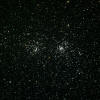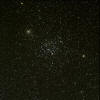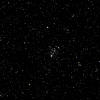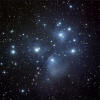M46 and NGC2438. The Cluster is Messier 46 and is easily seen in binoculars in the constellation of Puppis. The small violet and white puff of smoke is NGC 2438 and is a planetary nebula. The term planetary nebula was used by William Herschel and refers simply to an object that looks like a planet (small disc) in his telescope. Photographs reveal the intricacies of this and other planetary nebula such as M57 and M27. As discussed earlier Clusters are composed of young stars. However a planetary nebula is formed at the end of a stars life. How is it then that a planetary nebula is in an open cluster? Well it isn't , this is a perfect example of the fact that the Universe is 3 dimensional, The planetary nebula is actually much further away than the cluster and happens to be in the same line of sight. So in this one shot we have the youth and senility in the life cycle of stars.
The bright star and vertical streak in the lower right is due to 'blooming'. The CCD camera used does not have an Anti-blooming gate to drain off excess charge. So when the CCD pixel reaches a full charge the electrons overflow into to cells around it resulting in the spike when it is processed. There is also a satellite trail in the upper right of this picture.




